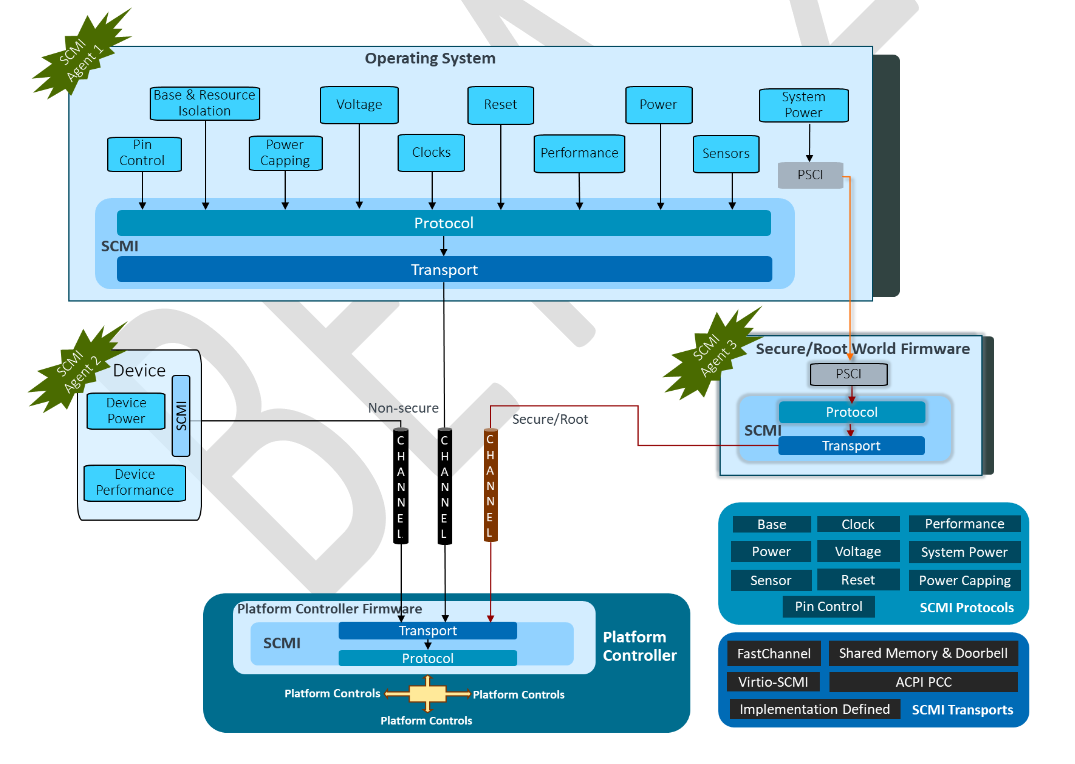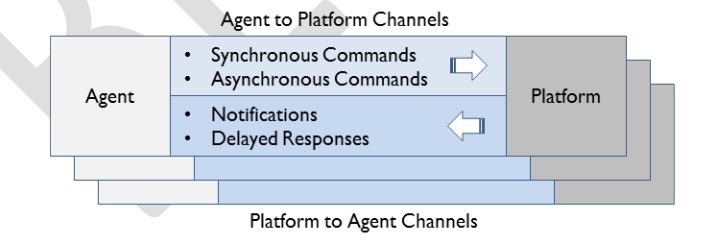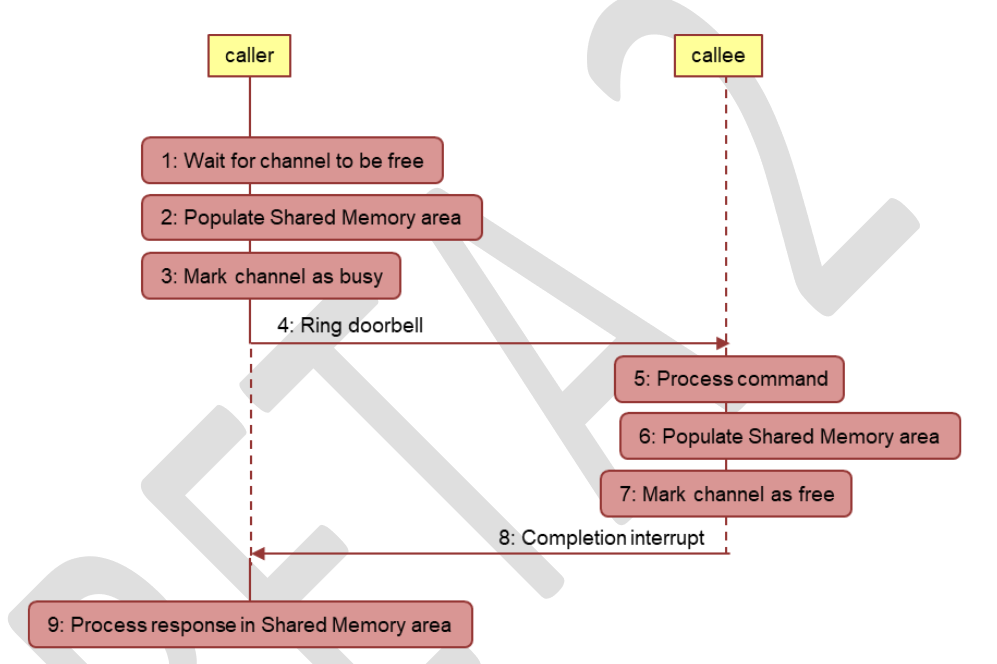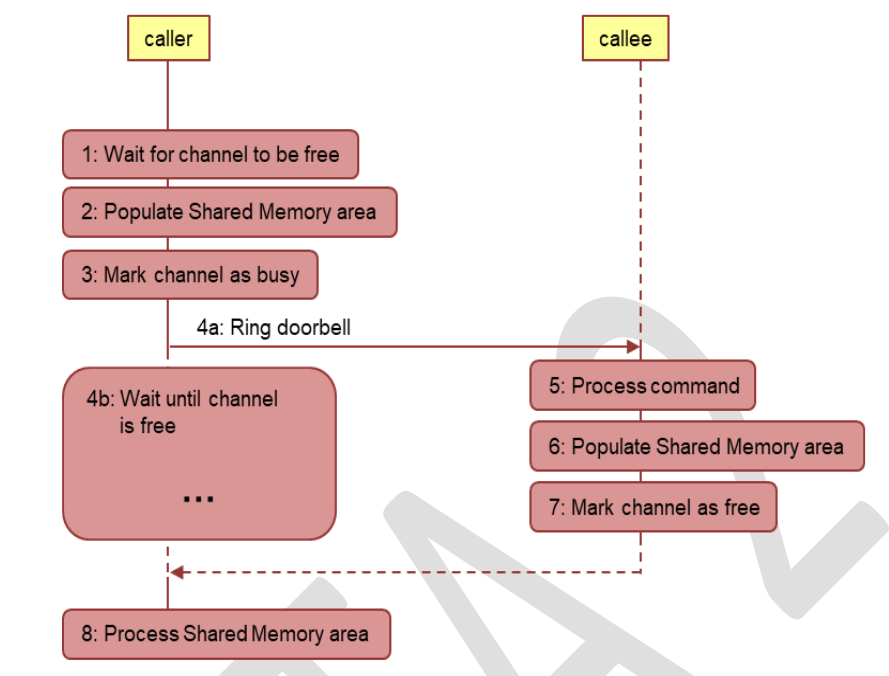SCMI(System Control and Management Interface)
介绍
SCMI是一套独立于操作系统的软件接口,用于系统管理。SCMI是可扩展的,目前提供了以下接口:
- 所支持的接口的发现以及接口的描述。
- Power domain管理。将给定的device或domain设定到支持的各种power-saving state。
- Performance管理。控制不同计算引擎(CPU、GPU等)domain的performance。
- Clock管理。设置或者查看平台所支持的clocks。
- Sensor管理。读sensor的数据以及当数据改变时收到通知。
- Reset domain管理。将给定的device或domain设定到各种reset state。
- Voltage domain管理。配置和管理组件的电压。
- Power capping and monitoring。配置和调整power caps并且监控power capping domains的power消耗。
- Pin control。控制和配置pins。
❓ 为什么要出现SCMI
提供微控制器(microcontrollers)来将power或系统管理任务从APs中抽离出来是工业界的大势所趋。这些控制器通常通常有相似的接口,无论是在它们提供的功能方面,还是在请求如何与它们通信方面。通过SCMI接口可以将任务处理从APs转移到控制器上。
SCMI所定义的接口提供了两个抽象层次:
协议(Protocol)
每组功能相关的函数被归类成一个协议。因为SCMI接口是可扩展的,所以协议也会增加。
传输(Transport)
协议通过传输来进行通信。传输规范描述了agent和platform component之间如何进行通信,其中agent是协议的使用者,platform component对协议信息进行处理。
所使用的接口在firmware(FDT或ACPI)中进行描述。
SCMI结构
SCMI旨在允许agents管理硬件platform提供的各种功能,比如功耗和性能的管理。
🏷 名词解释
Protocols: 不同的协议分别定义了一组不同的系统控制和管理。
Transport: 描述了Agent和Platform之间通信的方法。
Agent: 系统控制和管理的调用者(caller)。
Platform: 硬件组件的集合,用来对通信信息进行解析并且执行相应的功能(callee)。
Resource: 硬件平台的组件,可以通过SCMI信息来被控制。
每个transport可以提供多个channels。每个agent在和platform通信时必须有一套专属的channels。换而言之,不同的agent之间不能共享channels。此要求消除了在运行完全不同软件堆栈的agent之间创建锁原语的需要。
下面图1展示了使用SCMI接口的示例系统。在此示例中,Platform包括了一个 SCP,用来处理从AP发出的命令。AP和SCP进行通信使用的channel分别Secure/root和Non-Secure channel。

❔ None-secure和Secure/Root channel的区别是什么?
使用ARM TrustZone技术可以拥有Secure和None-secure channel。Agent可以处于Secure和None-Secure state。Non-Secure channel不可以访问或修改Secure Platform resources。Secure channel只能被处于Secure state的agent使用。
ARM RME(Realm Management Extension)引入了两种新的security states: Realm和Root。除了已经有的Secure和Non-secure PAS(Physical Address Spaces),使用SCMI的系统增加了Root PAS。表1说明了SCMI agents,channel和resource的访问规则。
| Agent Security State | SCMI Resource Assignment and Channel PAS | ||
|---|---|---|---|
| Non-Secure | Secure | Root | |
| None-Secure | Allow | Deny | Deny |
| Secure | Allow | Allow | Deny |
| Root | Allow | Allow | Allow |
协议(Protocols)
如前文描述,协议是一组消息。下面将分别描述信息通信流程和信息的结构。
通信流程
Agents和Platform之间通过transport channel进行通信。Channel分为两种类型:SCMI Fastchannel和标准的SCMI channel。
- Fastchannel:是一个轻量级单向channel,专用于控制特定的Platform resource且拥有特定的SCMI信息类型。即一个Fastchannel只能作用于特定的一个任务。不需要提供多余的header,因此latency较低。
- standard channel:用于承载多种消息类型,且可以显式的控制多个Platform resource。需要header来声明信息类型。
下面的图2描述了agents和platform之间如何通过channel进行通信。

每个Agent都有专属的channels,用来发送信息或者从platform接受信息。除了Fastchannel,每个channel都是双向通信的。根据方向不一样,channel可以分为两种类型:
- A2P(Agent to Platform)channel,agent是请求者。
- P2A(Platform to Agent)channel,platform是请求者。
Transport支持两种通信方式:
- interrupt-driven communication:当完成任务时,通过中断来表明任务已经完成。
- polling-based communications:需要请求方通过polling的方式来判断任务是否完成。
Agent向Platform发的命令分别两种类型:
同步
命令始终block channel,直到被请求的工作完成。Platform通过A2P channel进行回应。所以channel只有在上次任务完成后才可以进行下一次任务。
异步
对于异步请求,platform对于请求的任务会稍后完成。因此,platform会立马对caller进行回应并free channel,使得下条命令可以发送。当异步任务完成后,platform通过P2Achannel发送类型为dealyed response的回应消息。
Platform通过P2A channel发送给agent的信息分别两种类型:
Delayed response
表明完成了异步通信的任务。
Notifications
当platform发生了某些事件后,可以主动向agent发送notification。
Fastchannel不支持异步请求,delayed response和notification。
信息(Message)的格式
Message类似于远程过程调用(Remote procedure call),因此必须可代表所请求的操作及其任何参数或返回值。
每个信息都携带了message header,用于标识所请求的操作。每条信息属于一个协议,因此header中包含了8-bit的协议标识,称为protocol_id。同时每条信息有一个唯一的8-bit的表示,称为message_id。
每个信息可有32-bit的参数以及32-bit的返回值。
protocol_id值的描述如下表2所示。
| protocol_id | Description |
|---|---|
| 0x0 - 0xF | Reserved |
| 0x10 | Base protocol |
| 0x11 | Power domain management protocol |
| 0x12 | System power management protocol |
| 0x13 | Performance domain management protocol |
| 0x14 | Clock management protocol |
| 0x15 | Sensor management protocol |
| 0x16 | Reset domain management protocol |
| 0x17 | Voltage domain management protocol |
| 0x18 | Power capping and monitoring protocol |
| 0x19 | Pin Control protocol |
| 0x1A-0x7F | Reserved for future use by this specification |
| 0x80-0xFF | Reserved for vendor or platform-specific extensions to this interface |
对所有使用标准channel的protocol和transports,Message通过32-bit的message header发送给platform。header格式如下表3所示。Fastchannel不适用message header,因为它只作用于独特的信息类型。
| Field | Mnemonic | Description |
|---|---|---|
| Bits[31:28] | - | Reserved, must be zero. |
| Bits[27:18] | token | Token. |
| Bits[17:10] | protocol_id | Protocol identifier. |
| Bits[9:8] | message_type | Message type. Value of 0x1 is reserved for future use. |
| Bits[7:0] | message_id | Message identifier. |
Message type分为三类:
- Commands, message type = 0。
- Delayed response,message type = 2.
- Notifications,message type = 3.
Example for Commands
CLOCK_TARE_GET,用于获取某个clk的频率。
| message_id: 0x6 protocol_id: 0x14 | |
| Parameters Name | Description |
|---|---|
| uint32 clock_id | Identifier for the clock device. |
| Return values Name | Description |
| int32 status | SUCESS if the current clock rate was successfully returned. |
| uint32 rate[2] | Lower 32 bits and Upper 32bits of the physical rate in Hertz |
传输(Transport)
Transport描述了agent和platform之间如何进行通信。
这种形式的传输依赖于在平台和代理之间使用shared memory。即支持基于中断的通信,还支持基于polling的传输。每个channel包含:
shared memory area
这是caller和callee之间共享的shared memory。shared memory被caller或callee所有。所有权由shared memory中的channel status字段决定。当shared memory被caller所有时,channel处于free状态;被callee所有时,channel处于busy状态。
当channel处于free时,caller可以向shared memory写信息以及相关的payload。然后caller更新channel status状态,将channel改为busy状态,此时,shared memory的所有权归callee。callee此时可以使用shared memory来填写请求的return value。当callee完成任务后,将channel重新设为free状态并通知caller任务已经完成,可以发送新的请求。
Doorbell
这是caller用于提醒callee消息存在的一种机制。
Completion interrupts
该传输支持polling和interrupt driven两种不同的通信模式。在interrupt driven模式下,当callee完成对消息的处理时,它会向caller发出中断。
Interrupt-driven Communications flow

Polling based Communication Flow

基于ACPI的传输
略。详见SCMI spec.
略。详见SCMI spec.
Virtio-SCMI
略。详见SCMI spec.
经典问题
❓ 当callee将channel set free,但此时caller对该请求出现了超时,此时caller开始发送下一条命令,此时caller写shared memory覆盖了callee的答复,在覆盖之后caller收到了callee的完成中断,此时将出现overlay问题。
问题详细描述已经解见patch: firmware: arm_scmi: Check mailbox/SMT channel for consistency